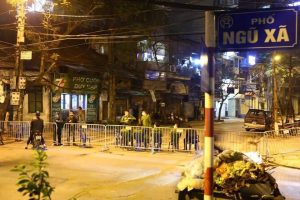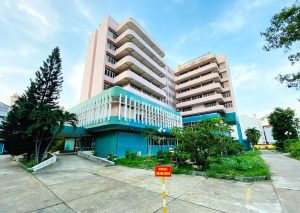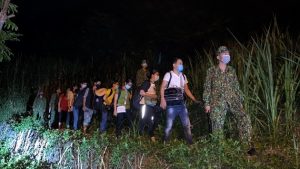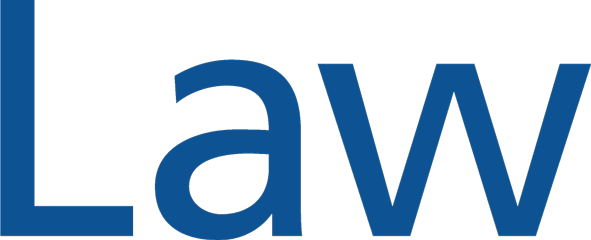Nguyen Huu Thinh
National University of Singapore
Faculty of Law
Patient 17: A Turning Point for Vietnam's "Wartime Spirit" during COVID-19
As of 20 July 2020, Vietnam had fewer than 400 confirmed cases and no fatality. This figure stands out in contrast to more developed countries with similar populations. Perhaps, this early success owes substantially to the Government’s invocation of “wartime spirit” and the public’s understanding of it through the case of Patient 17.
“Wartime spirit” is not a new term. It was popularized by Ho Chi Minh, a larger-than-life Vietnamese persona, when he called for nationwide defence against the eminent French invasion in 1946. Ordinary citizens were encouraged to fight with guns, swords, hoes, spades, wooden sticks, or anything that could be used to echo and partake the collective spirit of one people. “Wartime spirit” is therefore a term of historical importance. It evokes the feelings of Vietnamese people in a similar way as “I have a dream” does to many Americans. Unsurprisingly, “wartime spirit” has been recycled by contemporary politicians to rally public support.
But COVID-19 is different.
The wars which Vietnam went through were against physical adversaries. The coronavirus is, however, invisible. When the Government called for “wartime spirit” one more time, ordinary citizens wondered what it exactly meant in the context of a global pandemic. Maintaining personal hygiene was self-explanatory, but was it all that this spirit entailed?
Then, Patient 17 came into the picture.
Read more
Patient 17 rose to fame by accident (literally). After attending several luxury fashion shows in Europe, she returned to Noi Bai airport, Hanoi. On 06 March 2020, she developed flu-like symptoms and was tested positive around 9.30pm. The Government broke the news to the surprise— and widespread outrage— of an almost-sleeping nation. At 10.30pm, the COVID-19 National Steering Committee was convened in full business attire.
The Committee decided to lock down ward Truc Bach of 189 residents, in which Patient 17 resided, with physical barricades. Other residents flocked to markets and retail stores in the middle of the night to hoard essential items— even rice, an irony for the world’s third-largest exporter.
For two reasons, that night was a momentous juncture for Vietnam’s pandemic fight. One, it normalized future lockdowns as part of the Government’s COVID-19 strategy. Though characterised by critics as “authoritarian”, the Government deemed such lockdowns as necessary to contain the spread of the little-known virus. Two, and more importantly, the public’s reception of Patient 17 concretized the “wartime spirit” that had long remained only as a slogan.

Truc Bach ward was quickly barricaded at night. Pictured by Dan Tri.
There were three public reactions to bring about “wartime spirit” in this case.
The first was to demonize Patient 17. This was because she failed to declare her immigration history with the country’s border controls. As a dual citizen, she used her UK passport to travel around the UK, Italy, and France but reserved the Vietnamese one to return to Hanoi. In the following morning, tabloids ran sensational headlines, calling her “selfish and dangerous” and a “national sinner” for her breach of the law. From a social media influencer, she assumed a new label of an “international infector”.
Second, Patient 17 and other suspect cases were doxed. In the name of contact tracing, details of her family members and whom she had close contact with from Europe to Vietnam went viral. Everyone became a makeshift investigator because suddenly, identification of potential clusters turned into a life-and-death matter. As a result, Patient 17’s and others’ information was shared even before and in greater details than the official press release by Vietnam’s Ministry of Health.
The third was to deride and divide society. Online discussions of the wealthy background of Patient 17’s family quickly spiralled into rhetorics of us-versus-them. She was described as a “global nomad” and an “elite lady”, rekindling the dormant issue of economic inequalities in the country. More crucially, the case of Patient 17 set a precedent for public hatred toward subsequent returnees. “If you can afford to go overseas, why bother crawling back now?” This gave rise to blanket discrimination against Vietnamese citizens who fled virus-striken countries, labelling them as “foreign disease spreaders”.
In this “war”, Vietnam split into two: those living domestically with fewer privileges versus those living overseas seen with deeper pockets of wealth and opportunities. All of a sudden, overseas returnees— potentially bringing the virus home— were seen as physical adversaries. This bifurcation gained wider popularity when some returnees complained about the quality of life in government quarantine facilities, with remarks that they were “dirty and substandard”. Quite different from the unity seen in 1946, now, Vietnam pays a hefty price for “wartime spirit”.
Though on the brighter side, the bifurcation helped the public to identify their enemy. While the virus was invisible, those who potentially carried it was not. They, then, became subject to community policing and stripped off privileges they ordinarily had.
In this new world, individual privacy is less of a concern.
In theory, a person can be prosecuted for doxxing under Article 155 of the Vietnamese Criminal Code 2015— a position recently affirmed by The People’s Supreme Court in the context of the COVID-19 pandemic. However, as a popular Vietnamese saying goes, the will of the king bows to the customs of the community. There may be laws and regulations top-down, but enforcement is a rarity if it is deemed locally unpopular. Vietnam has a one-party political system but it does, seen in this light democratically, respond to prevailing public sentiment. Such an approach is vital particularly during this pandemic in which (real) public compliance is earned— not shoved down their throats.
As a result, the Government did not mount a sufficiently strong response to the public shaming of Patient 17.
Aside from the silence of government officials, there were nuanced (and wholly deficient) attempts by state newspapers to side with Patient 17. For instance, “Cuoc Song An Toan”, the official publication of the Labour Union of Vietnam, questioned the online criticism of Patient 17. The article argued that the response was “justified but may have been too much”. Indirectly, this was a warning to the public that they might have broken the law by attacking the character of the socialite. But the warning stopped there, serving only to deny institutional acceptance of doxxing and shaming. The Government was riding a tiger, confident that the foregrounding of public health over one’s right to individual privacy would help eradicate the virus— as it did for more than 3 months.
“Wartime spirit” is a term open for interpretations.
But at its core, it is about mass mobilization of the public. This— the ability to stir public discourse and engage citizens from all walks of life— is Vietnam’s signature response to COVID-19.
It cannot be easily replicated in other countries because embedded in the early success of containment is a notion of community spirit: everyone lives within a shared space and under one roof. From young, all children are taught in textbooks a legend that the first 100 Vietnamese people were born from the same womb (thus the popular use of “同胞” in Han Viet to refer to fellow citizens). Inevitably, a sense of togetherness forms the bedrock of the Vietnamese spirit. Throughout history, nationalism is lauded, individualism frowned upon. Public condemnation is hence, generally, a more effective form of punishment than formal prosecution. The public’s aggressive reception of Patient 17 is a characteristic manifestation of the deep-seated communitarian culture.
It is difficult to judge whether this culture is uplifting or regressive. But it has worked for a considerable time period before the arrival of the second wave. It has helped Vietnam overcome the tumultuous past, and, as we hopefully continue to see, the very unprecedented present.
Tracking Vietnam's Third Wave since November 2020
On 30 November 2020, Vietnam confirmed its first locally transmitted COVID-19 case after 89 days. This resembled the arrival of the second wave back in July 2020, prior to which Vietnam experienced 100 days with no new cases.
The third wave upended the nation because three months of safety had brought lives back to normal. This time round, a 28-year-old Vietnam Airlines flight attendant was held responsible. He served Vietnamese passengers on a repatriation flight arranged from Japan on 14 November 2020.
Upon arrival, the attendant, tagged as “Patient 1342”, was moved to a quarantine facility with 10 other air crew members. He subsequently tested negative twice for COVID-19 and was thus released from the facility after 4 days of stay (at that time, air crew members received a preferential treatment pursuant to Directive 3951/CV-BCĐ issued by the National Steering Committee on COVID-19).

Vietnam Airlines quarantine facility for air crew members in Ho Chi Minh City was shut down and disinfected following the news. Photo by Vietnam Airlines.
Read more
During the following 14-day stay-home notice, however, Patient 1342 went outside to eat and even attended a university for lessons. To complicate contact tracing even further, he called a male friend to sleep over, breaching quarantine rules. After Patient 1342 was confirmed positive in his final test on 28 November 2020, the friend, too, was found positive. Headlines dominated the media for the first community infection in Ho Chi Minh City— the most populous city of Vietnam with 9 million people. People were rightfully unhappy with such news. There were a few notable implications:
- The Prime Minister of Vietnam ordered an immediate investigation into the process and implementation of preferential quarantine for flight attendants. This resulted in temporary closure of Vietnam Airlines quarantine facilities.
- The Ministry of Transport issued a new Directive 12183/BGTVT-CYT 2020 to request stricter enforcement of the quarantine regulations for flight crew members.
- The Prime Minister of Vietnam ordered an immediate halt of commercial flights into the country, including those for high-profile business people and missionaries. This decision came at a greater need for stability in preparation for the quinquennial Assembly of the National Congress.
- The Vice-Chief of Ho Chi Minh City Police Department announced the decision to prosecute Patient 1342 under the infectious disease Article 240 of the Vietnamese Criminal Code 2015.
- Aside from expected criticism of Patient 1342’s recklessness, anti-LGBTQ+ sentiments reached a new high. This is because Patient 1342’s friend who stayed over— and got infected— is a gay male. Online attacks were focused on the gender of the infected individuals. These attacks were different in nature from those hammered on Patient 17 (during the first wave) because LGBTQ+ is very contentious. The Government remains largely silent on this issue; national newspapers avoid similar discussions.
The Current Situation (Including illegal border crossing)
Vietnam quickly contained the community spread in Ho Chi Minh City, within 4 days after Patient 1342’s positive result, i.e. 02 December 2020. Only a handful of new community cases were detected and swiftly handled.
Even though the public were put on high alert, in reality, the quick containment means that lives get to return back to normal — except the more stringent enforcement of mask wearing.
As of 26 December 2020, there were 25 days with no community infection.
Latest update & developing story:
- Vietnam’s Ministry of Health confirmed on 26 December 2020 of one COVID-19 positive case. Patient 1440— a Vietnamese national— was originally from Myanmar and illegally crossed land borders into Vietnam via Cambodia.
- The exact route is determined to be across a river from Cambodia to Vietnam. Land border controls are extremely difficult due to the treacherous topography. As Lunar New Year is coming soon, the threat of hundreds of immigrants pouring into Vietnam from different directions (north from China, west from Cambodia and Laos) is very imminent. This issue was previously raised in page 20 of the first document.
- People still risk their lives trying to cross borders because Vietnam currently does not operate commercial flights into the country, even for Vietnamese citizens. The underlying reason is perhaps that the relatively poor national healthcare infrastructure will collapse if there is widespread community infection. As a result, Vietnam currently pursues a policy of dropwise repatriation.
- Preliminary investigations revealed that Patient 1440 is part of a group of 6 Vietnamese nationals returning from Myanmar. Four out of six have tested positive.
- Besides, extensive contact tracing is underway to ring-fence potential infections. The entire Vinh Long province where Patient 1440 resided is now recommended to go out only if necessary, and to wear a mask at all times. Ho Chi Minh City, where some new cases were recently discovered, is similarly on high alert.
- The Prime Minister of Vietnam has called for a nationwide campaign for all citizens to police and actively report cases of illegal immigration at the border areas. This will aid contact tracing efforts. In addition, engaging ordinary citizens is likely to yield success because it awakens the communitarian culture of Vietnam.

Increased surveillance to arrest Vietnamese citizens illegal crossing land borders. Photo by Vietnam’s Ministry of Health.
Similarity to public outlash during Vietnam's second wave
i. LGBTQ+ issue and other ad hominem towards Patient 1342
Vietnam— similar to other societies— have a fair proportion of homophobic people. They capitalized on the community infection between Patient 1342 and his gay friend, who decided to sleep over and knowingly break stay-home notice regulations.
National tabloids and, surprisingly, state television channel VTV resisted the anti-gay sentiments. Zings News criticised homophobia, arguing that the ad hominem against Patient 1342 is unjustified and irrelevant: one should solely focus on his antisocial, law-breaking action.
Similarly, VTV (the equivalent of Singapore’s “The Straits Times”) highlighted the need to attack Patient 1342 on the basis of his behaviour and not his sexuality. This decision to be engaged is, in many ways, unprecedented because Vietnam still officially criminalizes homosexuality. However, the law remains unenforced for a long time. There have been innumerable cases of local celebrities and business people “coming out” as belonging to the LGBTQ+ community without fear of public prosecution. But never has the Government made an official statement regarding the enforceability of homosexuality laws.
ii. Damaged reputation of Vietnam Airlines
Patient 1342’s case study shed light on the preferential treatment for air crew members regarding quarantine, as well as Vietnam Airlines’ weak enforcement of the regulation. As a result, the national carrier suffered a marketing catastrophe. The company decided to run a “#WeApologize” online campaign in which all employees post on their social media positive images of Vietnam Airlines with the hashtag #WeApologize. It reminds people of the many good instances they have had with the airlines, especially for those who were on repatriation flights arranged by Vietnam Airlines from virus-stricken countries. Besides, Vietnam Airlines published a press release to apologize, explain, and promise to improve the quarantine conditions for their air crew members.

Vietnam Airlines staff on a flight during the COVID-19 pandemic. Photo by Tien Phong Newspaper.
Notably, the plight of Vietnam Airlines is not isolated: recently, Singapore Airlines has had a similar incident involving an air steward who returned from the United States and worked as a part-time Grab driver before testing positive. But due to social and cultural differences, the public reaction here is drastically different.
iii. Temporary halt of all incoming commercial flights
There are two reasons for the temporary halt of all incoming commercial flights.
One, to stem the inflow of more potential viruses. Vietnam’s pandemic response has always been characterised as an “overreaction”, though arguably a justifiable one looking at her eventual success. It would be political suicide to loosen air traffic at the moment because an excellent response to COVID-19 has been a silver lining for the party leadership.
Two, to protect the integrity and continuity of the upcoming quinquennial Assembly of the National Congress. This is when the Communist Party gathers to elect new leaders and quintessentially members of the Communist Party Politburo.

